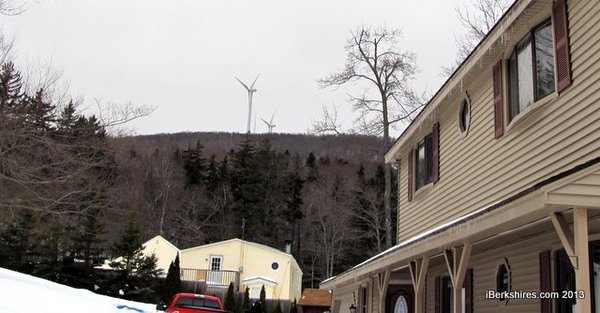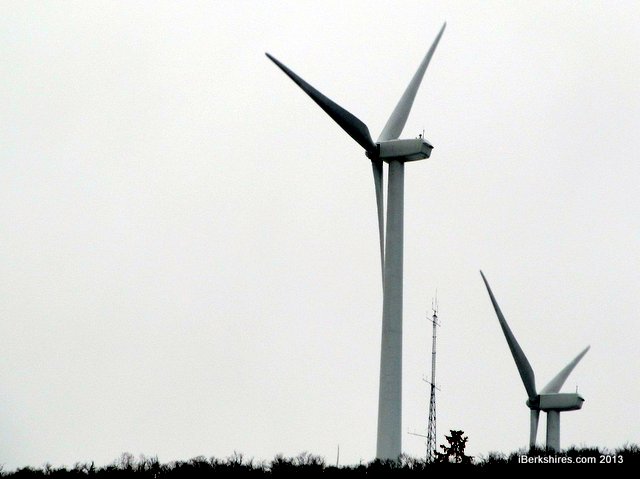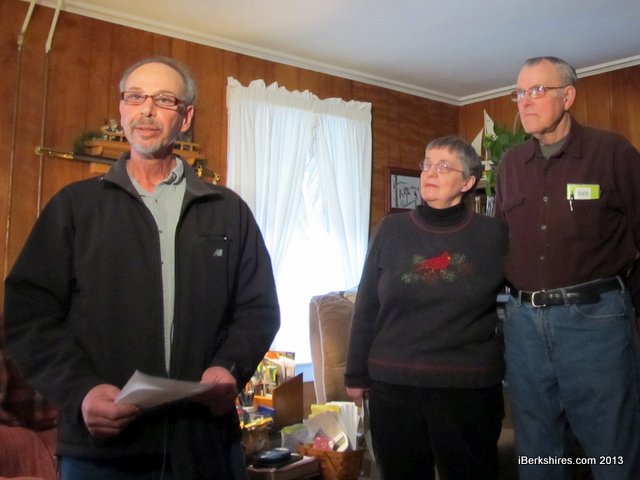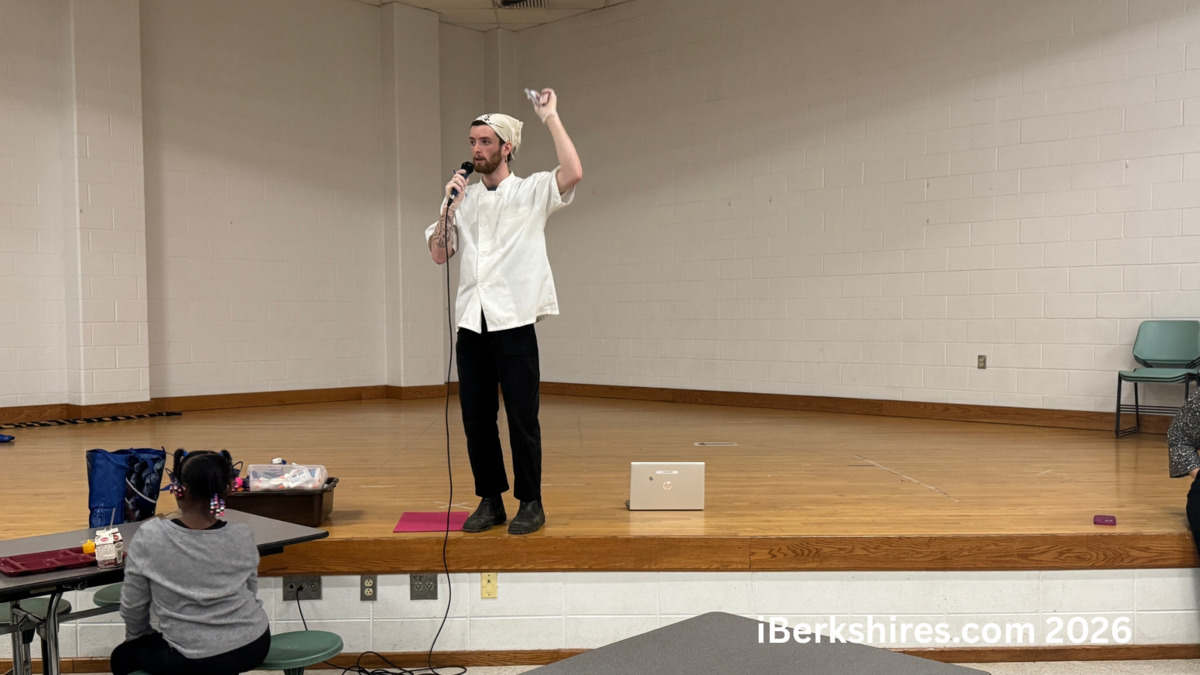
Hoosac Wind Neighbors Complain of Turbine Noise
|
Some residents living near Hoosac Wind Power say noise and flicker from the turbines are causing headaches and sleeping issues. |
FLORIDA, Mass. — The stories they tell are similar — constant headaches, ringing ears, pounding hearts, sleepless nights.
The cause of their concern can be seen sweeping the sky outside their windows.
On a cold Tuesday afternoon, George Berne pointed to the wind turbines towering over the trees a few thousand feet from his home on Moores Road, just over the border in Monroe.
"When they first put them in and started them up I didn't even know they would be heard by me, or even seen by me," said Berne, who is deaf and wears hearing aids. "We're right in the epicenter of this whole deal."
After a few seconds of listening, the hum of the turbines could be discerned over the whoosh of the wind.
Berne said the amplitude of the noise depends on the strength of the wind and its direction The wildlife has disappeared around his home, he said, and the humming and strobe-light effect of the blades wakes his grandchildren.
The 28.5-megawatt Hoosac Wind Power went online in mid-December after years of delays by a small contingent of neighbors and environmentalists who appealed the wetlands permitting for Iberdrola Renewables. The state's largest wind farm was heralded by Gov. Deval Patrick last December as shaping the future of energy.
Nineteen turbines standing some 340 feet tall were built on Bakke Mountain and Crum Hill, largely with the support of Florida and Monroe, which saw advantages to hosting a leading energy-generation farm that would provide jobs and tax dollars.
But neighbors who hadn't opposed the plans — or thought much about them — say their lives have been disrupted since the turbines started turning.
"We heard about the windmill project," said Mark Laveriere, who lives down the road from Berne. "Anything's a good idea, you have to give it a chance.
"Unfortunately, when they turned on was when the trouble started."
Laveriere, Berne and about a half-dozen others gathered at the home of Irving and Rosalyn Mullette on Tilda Hill Road, within sight of the turbines, to express their concerns and urge their neighbors to speak up.
"We're here today to get local people aware," said Michael Farineny, Berne's neighbor on the other side of the town line in Monroe. Farineny is a member of The Friends of Florida and Monroe, a group formed last fall in response to the turbines. The group has met with town and state officials, as well as Iberdrola representatives.
|
Michael Farineny, left, and Rosalyn and Irving Mullette are encouraging neighbors to contact DEP with complaints, hoping that will push the state to action. The Mullette said the noise even bothers their cat. |
"This problem has become so apparent to me that I'm trying to reach out to my neighbors and the people of the town," said Farineny, who's urging residents encountering problems with the turbines to contact the state Department of Environmental Protection. "If it's not done now, I'm very concerned that DEP will brush this stuff under the rug."
Despite ambitious plans for wind energy, Falmouth voters will decide whether to remove two municipal turbines; in New York, Iberdrola is being sued by 60 residents over noise pollution.
"At our Hoosac wind farm, we give serious consideration to all concerns regarding its operation," wrote Paul Copleman, communications manager for Iberdrola Renewables, in an email. "As a long-term community partner, we remain committed to working closely, as we have throughout the multi-year development and construction of the project, with the communities and individuals in and around the project."
Residents are specifically asking for noise monitoring, saying the turbines frequently exceed the state's 10-decibel limit and the guidelines don't take into account persistent low-frequency noise. Farineny said the state used a model for noise but never determined the actual ambient background in the wooded, low-density residential area.
State officials say they have received complaints about the noise and are working with Iberdrola.
"MassDEP has been tracking complaints from residents in the area and we have been in contact with the company about those complaints," wrote Edmund J. Coletta Jr., director of the DEP's Office of Public Affairs. "Mass DEP requested, and the company recently submitted, a plan for performing noise monitoring. We are working with the company to ensure the plan will evaluate conditions around the turbines."
Coletta said he couldn't speak further on the issue but did add that the plan should be finalized "shortly" and the company will begin monitoring.
Copleman said sound "is a complex issue."
|
George Berne said he moved to Florida years ago to get away from the noise and crime in Pittsfield. He didn't expect to hear turbine hum inside his secluded home. |
"We designed the project to be in compliance with all applicable regulations and we have an obligation to operate the project in accordance with those regulations," he wrote. "We have been made aware of concerns regarding sound from some of the project neighbors and we have been in communication with the Massachusetts DEP to discuss an appropriate sound monitoring plan."
Some experts are calling the effects "wind turbine syndrome," a condition that disrupts lives through sleeplessness, depression, headaches, dizziness, nausea and more. Others see communication and shared annoyance as the main culprit, not turbines. An expert study by the Department of Public Health released last year says there is limited or insufficient evidence on whether turbines are directly responsible for causing health problems, but considers noise could play a role.
For some of the turbines' neighbors, the syndrome is very real. They came to the hilltowns to get away from big-city noise, to find peace and quiet.
"You just can't get away from them, they're constantly going," said Rosalyn Mullette, 75, who had looked forward to spending her golden years with her husband in the home his father built. "We're concerned about the future and being able to stay in this home."
Tags: wind farm, wind noise, wind turbine,



.JPG)















